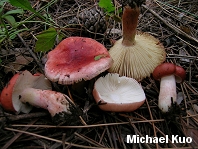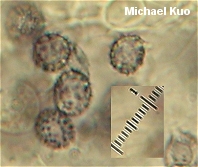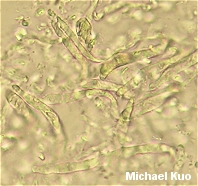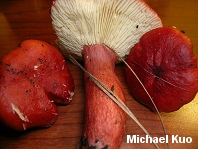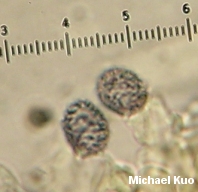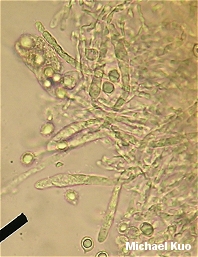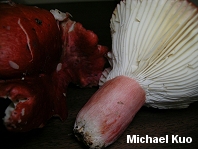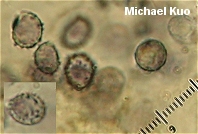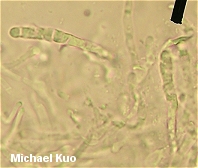| Major Groups > Gilled Mushrooms > Pale-Spored > Russula > Russula sanguinea |

|
"Russula sanguinea" in North America [ Basidiomycetes > Russulales > Russulaceae > Russula . . . ] by Michael Kuo I am treating "Russula sanguinea" as a red-capped, red-stemmed, acrid russula with firm flesh, a tightly adnate cap skin, and a yellowish to yellow spore print. Under the microscope it features well defined pileocystidia, and spores with fairly isolated warts. It is associated with pines--especially with two-needled pines like Bishop pine and red pine. There may be more than one phylogenetic species involved in this concept, and none is probably the same as the original European Russula sanguinea. A very similar species, Russula tenuiceps, occurs under oaks and other hardwoods in eastern North America; it features extremely fragile flesh and a very weak stem. Russula rosacea, in the sense of many authors, is a synonym. According to some mycologists, Russula sanguinaria is also a synonym. On the West Coast, Russula sanguinea has a look-alike in Russula americana, which according to Thiers (1997b) differs only in spore dimensions; its spores measure 9-11 x 8-11 µ. Russula americana may eventually be the name best applied to the West Coast versions of Russula sanguinea; while I doubt that it is truly distinct by virtue of spore dimensions and nothing else, it is a species name that represents an original collection from the Pacific Northwest (rather than Europe). The strikingly red stems of West Coast, sanguinea-like mushrooms are perhaps another morphological feature separating these mushrooms from their European and eastern North American counterparts, whose stems are usually substantially less red. Description: Ecology: Mycorrhizal with pines--especially 2-needled pines like Bishop pine and red pine--and perhaps with other conifers; growing alone, scattered, or gregariously; summer and fall, or over winter in warm climates; possibly widely distributed in North America. Cap: 2-10 cm; convex when young, becoming broadly convex to flat, sometimes with a shallow depression; sometimes sticky when fresh or wet; fairly smooth; dark to bright red but sometimes fading in age; the margin not lined or merely slightly lined at maturity; the skin fairly adnate, peeling only at the margin. Gills: Attached to the stem or running slightly down it; close; white when young but soon creamy to yellowish or yellow. Stem: 3-10 cm long; 1.5-2.5 cm thick; firm; colored like the cap or paler--or flushed red over a white base color; dry; fairly smooth. Flesh: White; unchanging when sliced. Odor and Taste: Odor not distinctive; taste quickly and usually strongly acrid. Spore Print: Creamy to yellowish or orange-yellow. Chemical Reactions: KOH on cap surface pale orange; iron salts on stem surface negative to pinkish. Microscopic Features: Spores 7-9 x 6-7 µ; with isolated warts REFERENCES: (Bulliard, 1781) Fries, 1836. (Saccardo, 1887; Burlingham, 1915; Beardslee, 1918; Bills & Miller, 1984; Arora, 1986; Kibby & Fatto, 1990; States, 1990; Phillips, 1991/2005; Lincoff, 1992; Metzler & Metzler, 1992; Thiers, 1997b; Barron, 1999; Miller & Miller, 2006.) Herb. Kuo 08110201, 01150509, 01120615, 09220606. This site contains no information about the edibility or toxicity of mushrooms. |
Above: An Illinos collection. Below: California collections.
© MushroomExpert.Com |
|
Cite this page as: Kuo, M. (2009, March). Russula sanguinea. Retrieved from the MushroomExpert.Com Web site: http://www.mushroomexpert.com/russula_sanguinea.html |
